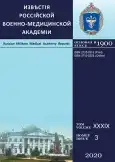Endoscopic esophageal stenting as a method of selecting and eliminating dysphagia syndrome in esophageal stenosis
- Authors: Belevich V.L.1, Brednev A.O.1, Kurlova O.G.1
-
Affiliations:
- Military Medical Academy named after S. M. Kirov
- Issue: Vol 39, No 3 (2020)
- Pages: 14-18
- Section: Original articles
- URL: https://journal-vniispk.ru/RMMArep/article/view/75981
- DOI: https://doi.org/10.17816/rmmar75981
- ID: 75981
Cite item
Full Text
Abstract
To assess of our study was to analyze the experience of using esophageal stents in dysphagia syndrome. The main questions to which they wanted to get an answer: the formulation of the main indications and contraindications for esophageal stenting; evaluation of the efficiency and feasibility of esophageal stenting with self-expanding metal stents in incurable patients. At the General Surgery Department of the S. M. Kirov Military Medical Academy performed stenting in 78 patients for malignant neoplastic processes and in 2 patients with benign esophageal stricture, who underwent treatment from 2007 to 2020. The patient group included 61 men (76.3%) and 19 women (23.7%). 69 people applied for grade III–IV dysphagia, 6 had tracheo-esophageal fistulas, and 3 had esophageal-pleural fistulas formed during tumor decay, 2 patients were treated for esophageal burn stricture. The stents of the Korean company «M. I. Tech». Installation were performed with short, small diameter endoscopic delivery systems. The onset of feeding, as a rule, began on the next day with satisfactory standing and adequate expansion of the stent, and no displacement. The patient could leave the hospital on the same day. Meals began with the use of water and liquid food with a gradual expansion of the density and consistency of the food. The minimally invasive method for eliminating dysphagia in inaccurate patients is esophageal stenting with self-expanding stents. Esophageal stenting has fewer complications than other invasive surgical techniques for resolving dysphagia. The advantage of palliative treatment of tumor stenoses and fistulas by stenting is to reduce the manifestations of dysphagia, improve the quality and increase the life expectancy of patients (3 figs, bibliography: 15 refs).
Full Text
##article.viewOnOriginalSite##About the authors
Valeriy L. Belevich
Military Medical Academy named after S. M. Kirov
Author for correspondence.
Email: koptata@mail.ru
M. D., D. Sc. (Medicine), Senior Lecturer of the General Surgery Department
Russian Federation, bld. 6, Akademika Lebedeva str., Saint Petersburg, 194044Anton O. Brednev
Military Medical Academy named after S. M. Kirov
Email: koptata@mail.ru
M. D., Ph. D. (Medicine), Lecturer of the General Surgery Department
Russian Federation, bld. 6, Akademika Lebedeva str., Saint Petersburg, 194044Olga G. Kurlova
Military Medical Academy named after S. M. Kirov
Email: izvestia-rvma@vmeda.ru
M. D., Endoscopist of the General Surgery Department
Russian Federation, bld. 6, Akademika Lebedeva str., Saint Petersburg, 194044References
Supplementary files










